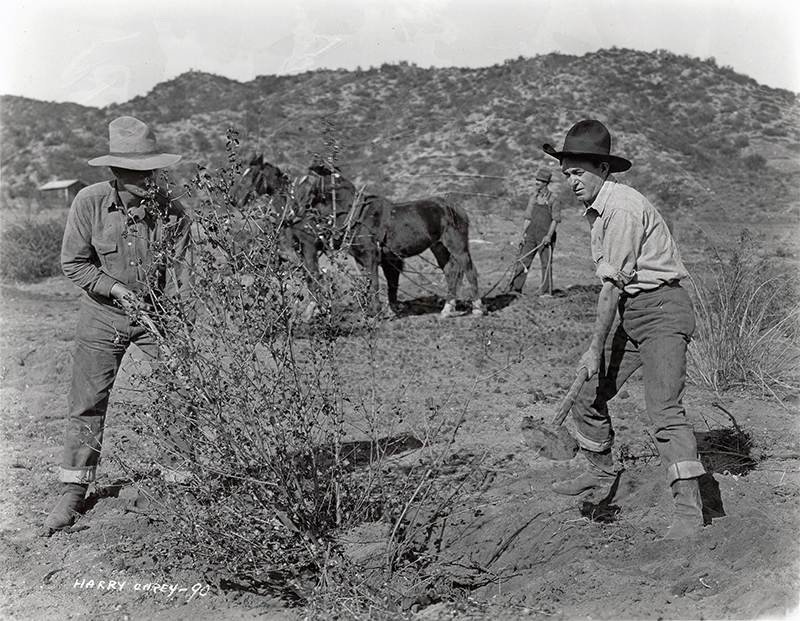|
|
Harry Carey Ranch, Saugus

Click image to enlarge
| [Full Original]
Actor Harry Carey at work on his ranch at the mouth of San Francisquito Canyon after the St. Francis Dam broke. The Harry Carey Ranch wasn't just a tourist attraction. In fact, after the 1928 dam disaster wiped out the Trading Post, it wasn't a tourist attraction at all. It may have been used for occasional filming after 1928, but the Careys ran sheep, cattle and hogs. The Carey family was in New York when the St. Francis Dam broke on the night of March 12, 1928. Afterward Harry Carey Sr. was reluctant to return. Their ranch manager Clinton Harter and his wife Marian had been killed, as was the Careys' cook, Solomon Bird. All three lived at the trading post, which Clinton and Marian operated. And now, even the trading post was gone. When the family did finally return, Harry Carey threw himself into the work of restoring the property into a true working ranch — as opposed to the tourist attraction it had been. "He said, 'I won't go back to that graveyard,'" Harry Carey Jr. (Dobe) remembered in a 2005 interview. "Finally my mom, our mom, drove up with our uncle ... and looked it over, and she came back and she told our dad that it was like a sick child that needed caring for. And then he went up and looked at it and they said, 'Let's move back.'" "It was the happiest time of my father's life," the younger Harry Carey said, "reconstructing that old place, which had been abused by tourists and stuff there. A lot of people shooting holes in things ... When he was back there, fixing that place up again, I think it was the happiest time of his life. He was just in seventh heaven." "We were all kind of camping out while he was nailing up the boards," Harry Sr.'s daughter Ella (Cappy) added.
About Harry Carey Sr. Actor Harry Carey (Sr.) acquired a homestead at the mouth of San Francisquito Canyon in 1916 and established a rancho. The ranch included the Carey's wooden ranch home as well as several outbuildings and the Harry Carey Trading Post, which was a tourist attraction that included billed entertainment from Navajo Indians and other performers, along with a store that sold Western and Indian curios. The ranch was occasionally used for filming. The Careys' son, Harry Carey Jr. (Dobe), who would follow in his father's acting footsteps, was born in the Carey ranch home in 1921. The trading post washed away in the St. Francis Dam disaster of March 1928 and was not rebuilt. The Indians left about a month earlier, son Dobe said in a 2005 interview. Dobe said a shaman saw "a big crack and predicted it would break." The ranch house was situated at a higher elevation and survived the flood, only to burn down in 1932. The Careys replaced it by building a Spanish adobe home, which they sold with the rancho in 1945. Harry Carey was born Henry DeWitt Carey II on January 16, 1878 on 116th Street in the Bronx section of New York City. His father was a special-sessions judge and president of a sewing machine company. Harry attended a military academy but declined an appointment to West Point, instead trying his hand as a playwright. According to the Internet Movie Database: In 1911, his friend Henry B. Walthall introduced him to director D.W. Griffith, for whom Carey was to make many films. Carey married twice [correx: 3 times; see here], the [third] time to actress Olive Fuller Golden (aka Olive Carey), who introduced him to future director John Ford. Carey influenced Universal Studios head Carl Laemmle to use Ford as a director, and a partnership was born that lasted until a rift in the friendship in 1921. During this time, Carey grew into one of the most popular Western stars of the early motion picture, occasionally writing and directing films as well. In the 1930s he moved slowly into character roles and was nominated for an Oscar for one of them, the president of the Senate in "Mr. Smith Goes to Washington" (1939). He worked once more with Ford, in "The Prisoner of Shark Island" (1936), and appeared once with his son, Harry Carey Jr., in Howard Hawks' "Red River" (1948). He died Sept. 21, 1947, in Brentwood, after a protracted bout with emphysema and cancer. Ford dedicated his remake "3 Godfathers" (1948) "To Harry Carey — Bright Star Of The Early Western Sky." Carey would appear in at least 233 films, including short features, between 1909 and 1949. Further reading: Harry Carey Ranch: Historic American Buildings Survey No. CA-2712.
DC3011: 9600 dpi jpeg from original print courtesy of Harry Carey Jr. |

Interview: Dobe & Cappy Carey 2005 SEE ALSO: • Harry Carey Jr. in the Movies • More Harry Carey Ranch Photos
|
The site owner makes no assertions as to ownership of any original copyrights to digitized images. However, these images are intended for Personal or Research use only. Any other kind of use, including but not limited to commercial or scholarly publication in any medium or format, public exhibition, or use online or in a web site, may be subject to additional restrictions including but not limited to the copyrights held by parties other than the site owner. USERS ARE SOLELY RESPONSIBLE for determining the existence of such rights and for obtaining any permissions and/or paying associated fees necessary for the proposed use.






















